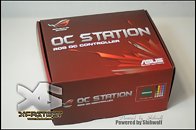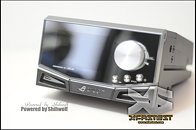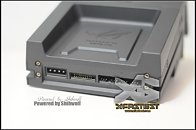- Joined
- Oct 9, 2007
- Messages
- 47,485 (7.49/day)
- Location
- Hyderabad, India
| System Name | RBMK-1000 |
|---|---|
| Processor | AMD Ryzen 7 5700G |
| Motherboard | ASUS ROG Strix B450-E Gaming |
| Cooling | DeepCool Gammax L240 V2 |
| Memory | 2x 8GB G.Skill Sniper X |
| Video Card(s) | Palit GeForce RTX 2080 SUPER GameRock |
| Storage | Western Digital Black NVMe 512GB |
| Display(s) | BenQ 1440p 60 Hz 27-inch |
| Case | Corsair Carbide 100R |
| Audio Device(s) | ASUS SupremeFX S1220A |
| Power Supply | Cooler Master MWE Gold 650W |
| Mouse | ASUS ROG Strix Impact |
| Keyboard | Gamdias Hermes E2 |
| Software | Windows 11 Pro |
The ASUS Republic of Gamers (R.O.G) OC Station first surfaced at the CES event earlier this year, where it was referred to as G-Panel. Heading towards a gala Computex launch, perhaps along with the recently pictured Crosshair III Formula, the OC Station represents the company's attempts to woo the professional overclocker with a hardware OC management device.
The ROG OC Station is a device that features controls for the system's overclocking on the fly, along with various temperature, voltage, and fan speed control/monitoring added to the mix. As a fan controller, the OC station provides output to four fans. The device connects to the ROG series motherboard and provides "hardware-based OC", meaning that it isn't merely a human-interface extension for a software running on the OS. Controls are care of three buttons along with a rotary switch, while a TFT-LCD screen keeps the user posted about clock-speeds, voltages, fan-speeds and temperatures, which might help when the system's display is busy running a 3D benchmark. The device can be used on the desk, where it's front panel moves along a hinge, for better user orientation, or its 2U size can occupy two 5.25-inch drive bays on a PC case.



View at TechPowerUp Main Site
The ROG OC Station is a device that features controls for the system's overclocking on the fly, along with various temperature, voltage, and fan speed control/monitoring added to the mix. As a fan controller, the OC station provides output to four fans. The device connects to the ROG series motherboard and provides "hardware-based OC", meaning that it isn't merely a human-interface extension for a software running on the OS. Controls are care of three buttons along with a rotary switch, while a TFT-LCD screen keeps the user posted about clock-speeds, voltages, fan-speeds and temperatures, which might help when the system's display is busy running a 3D benchmark. The device can be used on the desk, where it's front panel moves along a hinge, for better user orientation, or its 2U size can occupy two 5.25-inch drive bays on a PC case.



View at TechPowerUp Main Site
Last edited:








 Okay a bit far off, but still. Oc'ing being this easy can lead to many innocent hardware devices dieing.
Okay a bit far off, but still. Oc'ing being this easy can lead to many innocent hardware devices dieing.

